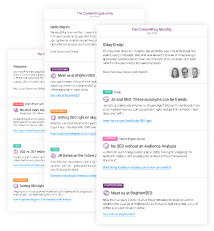Introduction
When visitors are on your website you want them to convert. In order to understand their journey through your website you need to track whether they consume your content, whether they interact with your website and whether they convert. You need to track this in order to learn from it so you can improve your content and website.
When it comes to web analytics and reporting tools, you can easily get lost if you don't know what to look for. In this article I cover the most important content engagement Key Performance Indicators (KPIs for short) you should be tracking.
These KPIs are split up in three categories:
- Behavioral
- Content interaction
- Conversion
Tracking KPIs per dimension
Before we get into detail, it's vital to understand that KPI data can differ tremendously per dimension. Therefore, analyse your KPIs per dimensions.
When I talk about dimensions, I mean:
- content type
- channel
- device
- type of visitor
- period in time
Different content types
Each content type serves a different purpose, so it's likely you see different visitor behavior. Your homepage serves a completely different purpose than your most recent blog article.
Different channels
Visitors from different channels behave differently on your website. A visitor that came to your website through a partner website is more likely to be within your target audience than an organic visitor who's just looking for some information.
Different devices
By default a lot of online marketers approach their web analytics data solely from a desktop point of view. That's incorrect, the days of the desktop-only era are long gone.
In some markets mobile and tablet visitors even trump desktop visitors. We have been living in a cross-device world, so it's essential to segment your users based on type of device when analysing your KPIs.
Type of visitor
Visitors come in different size and shapes. Some visitors may buy from you every two weeks. You may even know their first name by heart. Others just arrived on your website and don't know your brand yet. They display different behavior, and in order to make sense of your KPI data you need to segment based on the type of visitor.
Different periods in time
In order for you to gain insight in the progress (or regression) of your website, compare KPIs from different periods in time. I usually check at least these periods:
- Last week compared to the week before.
- Last month compared to the month before (seasonal influences may skew this data).
- Last month compared to the month in the previous year (e.g. June 2016 vs. June 2015).
Besides seasonal influences, take (national) holidays into account. Depending on your type of business, the holiday season can be rather slow or booming.
Behavioral KPIs

Behavioral KPIs relate to the basic behavior of your visitors. These KPIs comprise:
- Average time visitors spend on your website: the longer visitors stay on your website the better.
- Visited pages per session: the higher the amount of visited pages per session the better. Your visitors aren't hitting dead-ends within your website, they're encouraged to visit other pages within your website.
- Bounce rate: the lower the bounce rate the better. Bounce rate is the percentage of visitors leaving the website after visiting only one page without interacting with your website.
- Returning visitors: your content was good enough for visitors to return to your website. You're intriguing them, that's great!
Not black and white
Please note that it's not black and white when it comes to these KPIs. Visitors can of course head straight for their goal on your website and convert, without spending much time on your website, only visiting a few pages and not return to your website. Obviously you're happy with these types of visitors even though the KPIs above may say otherwise.
Content interaction KPIs

It's nice to see the behavioral interaction KPIs from the previous section, but seeing visitors interact with your website is even better. When I talk about interacting, I'm referring to:
- Scroll depth: Google Analytics supports firing events when people reach certain scroll depths. So you can measure whether visitors scroll down 25%, 50%, 75%, 100% of your content. If you want to read more about this, I recommend reading Justin Cutroni's advanced content tracking article (opens in a new tab).
- Sharing articles on social media
- Leaving comments on articles
- Upvoting (or downvoting) articles
When it comes to content interaction metrics, these also differ a lot per dimension. Take for example the dimension content type, it's much more likely for your blog articles to get shared on social media than your homepage.
Conversion KPIs

Conversions are the ultimate metric of visitors showing interest in your content. When we look at conversions, we should differentiate between eCommerce websites and regular website.
eCommerce websites
If you've got an eCommerce website you need to have eCommerce tracking in place besides goal conversion tracking. eCommerce tracking entails tracking the details of orders coming in.
For eCommerce websites you should pay close attention to the metrics:
- eCommerce conversion rate: the percentage of visitors ordering.
- Revenue per visitor: the average revenue made from one visitor.
- Goal conversion rate: the percentage of visitors completing goals.
- Goal completions: the amount of completed goals (e.g. filled out contact forms and newsletter subscriptions).
Regular websites
For regular websites the following metrics apply:
- Goal conversion rate: the percentage of visitors completing goals.
- Goal completions: the amount of completed goals (e.g. filled out contact forms and newsletter subscriptions).
What to remember?
We differentiate between three types of KPIs: behavioral KPIs, content interaction KPIs and conversion KPIs. Track these KPIs on a regular basis and compare them to periods in the past to see progression or regression. Use these KPIs to define follow-up actions.
Remember different content types, channels, devices and periods in time heavily influence your KPI data. Segment your data as much as possible to truly understand how your website is performing.


